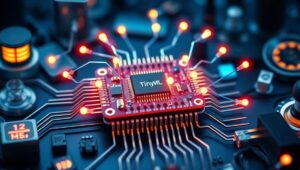TinyML: Machine Learning on Microcontrollers – The IoT Trend of 2025
As the Internet of Things (IoT) continues to expand, the need for efficient and intelligent edge computing solutions is growing rapidly. TinyML, a field focused on deploying machine learning models on resource-constrained devices like microcontrollers, is emerging as a key enabler for this trend. By 2025, TinyML is poised to revolutionize IoT applications across various industries.
What is TinyML?
TinyML involves compressing and optimizing machine learning models to run on microcontrollers with limited memory and power. Unlike traditional cloud-based machine learning, TinyML enables on-device data processing, reducing latency, enhancing privacy, and minimizing energy consumption.
Key Benefits of TinyML
- Low Power Consumption: TinyML models are designed to operate on minimal power, making them ideal for battery-powered IoT devices.
- Reduced Latency: On-device processing eliminates the need for data to travel to the cloud, resulting in faster response times.
- Enhanced Privacy: Data is processed locally, reducing the risk of sensitive information being exposed.
- Cost Efficiency: By reducing the need for cloud resources and data transmission, TinyML can significantly lower operational costs.
Applications of TinyML in IoT
- Predictive Maintenance:
- TinyML-powered sensors can analyze equipment performance data in real-time to predict potential failures, reducing downtime and maintenance costs.
- Smart Agriculture:
- Microcontrollers equipped with TinyML models can monitor soil conditions, weather patterns, and crop health to optimize irrigation, fertilization, and pest control.
- Healthcare Monitoring:
- Wearable devices can use TinyML to analyze vital signs, detect anomalies, and provide personalized health recommendations.
- Smart Homes:
- TinyML enables intelligent home automation systems that can recognize voice commands, detect occupancy, and adjust lighting and temperature based on user preferences.
Challenges and Opportunities
Despite its potential, TinyML faces several challenges, including limited computational resources, model optimization complexities, and the need for specialized expertise. However, ongoing research and development efforts are addressing these challenges, paving the way for widespread adoption.
The future of TinyML looks promising, with advancements in model compression techniques, hardware acceleration, and software tools making it easier to deploy machine learning models on microcontrollers. By 2025, TinyML is expected to be a mainstream technology in the IoT landscape, enabling a new generation of intelligent and efficient edge computing solutions.
In conclusion, TinyML is set to transform the IoT landscape by bringing machine learning to microcontrollers. Its benefits in terms of low power consumption, reduced latency, enhanced privacy, and cost efficiency make it a compelling solution for a wide range of applications. As the technology matures and becomes more accessible, we can expect to see TinyML playing an increasingly important role in the future of IoT.




